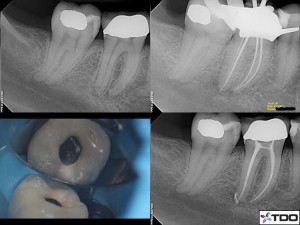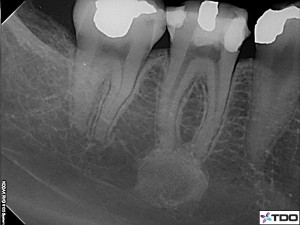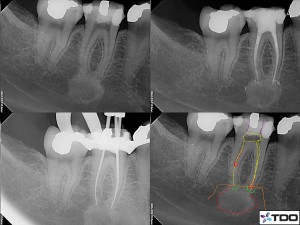Tooth #19 tests vital, no sensitivity to percussion. Conservative restoration and no caries present. Patient in no discomfort, presents secondary to a radiographic finding at a recall examination. African American heritage.
If you look closely you can see a radiolucent area that appears to be associated with the apex of tooth #19. However, you can also clearly see the narrow black line that is adjacent to each root tip. This line is the space occupied by the periodontal ligament.
The function of the PDL is to connect the tooth to bone, and the fact that there is easily identifiable radioopaque tissue adjacent to this line in both directions and the line is symmetrical represents a state of health.
In addition, the patient is of African descent(African American), and fibro-osseous lesions are commonly seen in these patients. In conjunction with our clinical testing, no endodontic treatment was performed.
Tooth #30 tests nonresponsive to cold, sensitive to percussion. Full crown restoration. Patient in pain without stimulation, was sent over from her general dentist due to her discomfort.
There appears to be slight radiographic changes periapically. Unlike case #1, it is difficult to isolate an intact PDL space or a clear and symmetrical relationship between radioopaque tissue and the space itself. As such, in combination with clinical testing, endodontic treatment was performed over two visits using Calcium hydroxide as an interim medicament.
Here is a tooth #30 that had therapy initiated prior to seeing us.
This tooth was not responsive to cold, but was sensitive to percussion. It was unclear why treatment was initiated, but due to the previously initiated therapy, this tooth required endodontic treatment. There is clearly something happening periapically. Condensing osteitis is a distinct possibility. This is a case that needs to be seen on recall.
Some things to think about:
1. We don’t treat radiographs, we treat people. Tying clinical findings to radiographic findings will help you prevent unneeded endodontic therapy.
2. Don’t be afraid to consider the ethnic background of the patient when making clinical determinations. There are a number of oral conditions and anatomical configurations that occur commonly in certain populations while it is almost unheard of in others.
3. Recall visits are important to assess the outcome of treatment as well as nontreatment. Don’t be afraid to set aside a little time to observe conditions over a period of time.
4. Happy New Year!




